Dental Care
What happens during the exam?
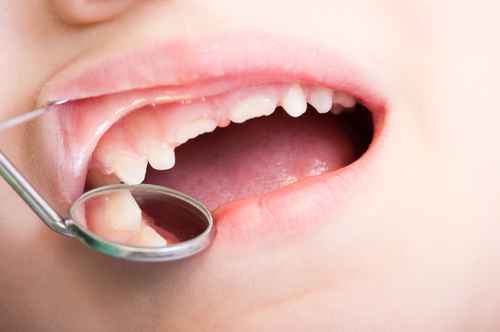 At every exam we will review your child’s health history; take any necessary x-rays; clean your child’s teeth (if any are present); conduct a thorough clinical examination of your child’s mouth, palate, gums, tongue and teeth; and teach them about good food choices and how to brush and floss their teeth. Prevention in dentistry is the best treatment we can offer!
At every exam we will review your child’s health history; take any necessary x-rays; clean your child’s teeth (if any are present); conduct a thorough clinical examination of your child’s mouth, palate, gums, tongue and teeth; and teach them about good food choices and how to brush and floss their teeth. Prevention in dentistry is the best treatment we can offer!
After every examination, we provide parents with essential information about your child’s dental health:
• An assessment of your child’s risk for decay;
• An evaluation of your child’s soft tissues and gums;
• An evaluation of your child’s bite and dental growth; and
• An assessment of your child’s oral health as it pertains to his or her overall health including suggestions about nutrition.
Tell me about dental x-rays (Radiographs)
Radiographs (X-Rays) are a vital and necessary part of your child’s dental diagnostic process. Without x-rays, certain dental conditions can and will be missed because they can’t be seen solely by visual examination.
Radiographs allow us to diagnose and treat health conditions, to evaluate the results of an injury or to plan an orthodontic treatment. If dental problems are found and treated early, dental care is more comfortable for your child.
We recommend obtaining radiographs when necessary. This will be different for each child. For most children this works out to approximately every two years, although that may be more frequent for children with a high risk of tooth decay.
Are dental x-rays safe?
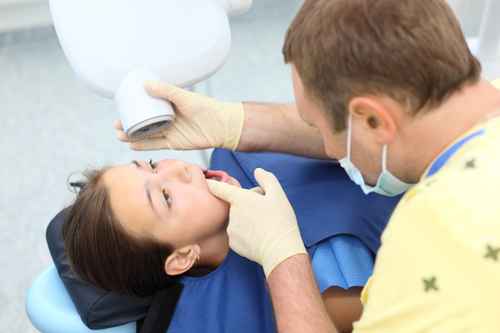 With contemporary safeguards, the amount of radiation received in a dental X-ray examination is extremely small and the risk is negligible. We use digital x-rays, which further lowers radiation, as well as lead body aprons and shields to protect your child. Today’s equipment filters out unnecessary x-rays. Shielding assures that your child receives a minimal amount of radiation exposure.
With contemporary safeguards, the amount of radiation received in a dental X-ray examination is extremely small and the risk is negligible. We use digital x-rays, which further lowers radiation, as well as lead body aprons and shields to protect your child. Today’s equipment filters out unnecessary x-rays. Shielding assures that your child receives a minimal amount of radiation exposure.
Dental radiographs represent a far smaller risk than an undetected and untreated dental problem!
Why do you want to know about my child’s diet?
Healthy eating habits lead to healthy teeth. Children need to eat a variety of foods from the five major food groups (protein, dairy, vegetables and fruit, grains, fats). Like the rest of the body, the teeth, bones and the soft tissues of the mouth need a well-balanced diet.
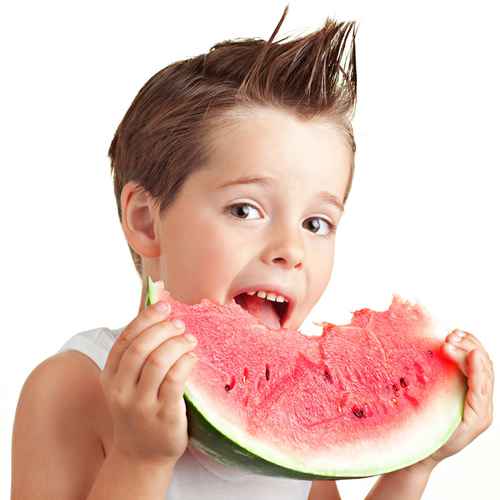 The more frequently a child snacks, the greater the chances are for tooth decay. When your child eats between meals, choose nutritious and yummy foods such as vegetables, low-fat yogurt, and low-fat cheese. Avoid sticky candy and other foods high in processed sugar or corn syrup. Read the nutritional labels on packaged foods so you can make good choices for your children.
The more frequently a child snacks, the greater the chances are for tooth decay. When your child eats between meals, choose nutritious and yummy foods such as vegetables, low-fat yogurt, and low-fat cheese. Avoid sticky candy and other foods high in processed sugar or corn syrup. Read the nutritional labels on packaged foods so you can make good choices for your children.
Back to Top
What can I do to prevent cavities in my child?
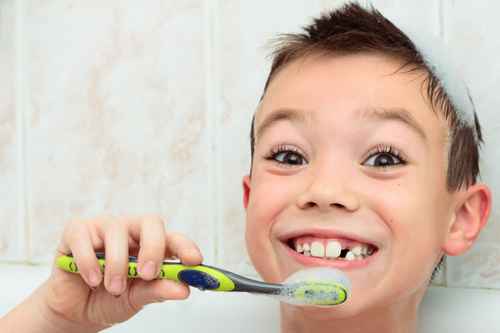 For infants, we recommend using a wet gauze or clean washcloth and gently to wipe the plaque from your baby’s teeth and gums. Do this after the morning feeding and before your child goes to sleep for the night. Avoid putting your child to bed with a bottle filled with anything other than water.
For infants, we recommend using a wet gauze or clean washcloth and gently to wipe the plaque from your baby’s teeth and gums. Do this after the morning feeding and before your child goes to sleep for the night. Avoid putting your child to bed with a bottle filled with anything other than water.
Toddlers and children just starting school need to have an adult help them brush their teeth at least twice a day and floss daily. Fine motor skills used in brushing don’t develop in children until at least ages 6-7. Your child can be ready to brush their teeth unsupervised if they are able to write in cursive or tie their shoes without assistance.
Many children respond well to using an electric toothbrush. Ask us about when to start and how to introduce this into your child’s tooth routine.
Be sure your child receives regular dental checkups and cleanings every six months up until age 16. If your child is at high risk for tooth decay, has had cavities or is in braces, we may recommend more frequent visits. And of course, always teach and encourage your children to make healthy food choices at meals and for snacks.
My child won’t go to sleep without nursing or taking a bottle.
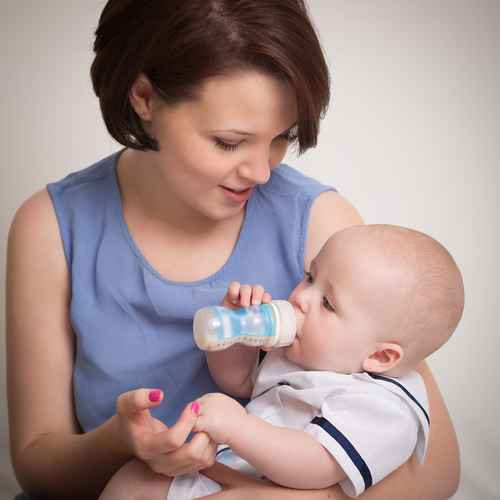 One serious form of decay among young children is baby bottle tooth decay, sometimes referred to as ‘bottle rot.’ The official, proper name of this condition is called Early Childhood Caries (ECC). This condition is caused by frequent and long exposures of an infant’s teeth to liquids that contain sugars. Among these liquids are milk (including breast milk), formula, fruit juice and other sweetened drinks.
One serious form of decay among young children is baby bottle tooth decay, sometimes referred to as ‘bottle rot.’ The official, proper name of this condition is called Early Childhood Caries (ECC). This condition is caused by frequent and long exposures of an infant’s teeth to liquids that contain sugars. Among these liquids are milk (including breast milk), formula, fruit juice and other sweetened drinks.
If you give your child a bottle filled with juice or milk, or breastfeed them before putting them to sleep, it could cause serious and rapid tooth decay. The reason? Sweet liquid pools around the child’s teeth and gives plaque bacteria an opportunity to produce acids that attack tooth enamel. During the day, saliva produced in your child’s mouth protects teeth from these acids, but at night saliva production decreases and the teeth are left more vulnerable.
If you must give your baby a bottle as a comforter at bedtime, it should contain only water. If your child won’t fall asleep without the bottle and its usual beverage, gradually dilute the bottle’s contents with water over a period of two to three weeks until your child becomes used to only water at bedtime. After the final nighttime feeding (including breastfeeding), brush or wipe the baby’s gums and teeth with a damp washcloth or gauze pad to remove plaque. The easiest way to do this is to sit down, place the child’s head in your lap or lay the child on a dressing table or the floor. Whatever position you use, be sure you can see into the child’s mouth easily.
Why are baby teeth so important? They’ll be replaced anyway.
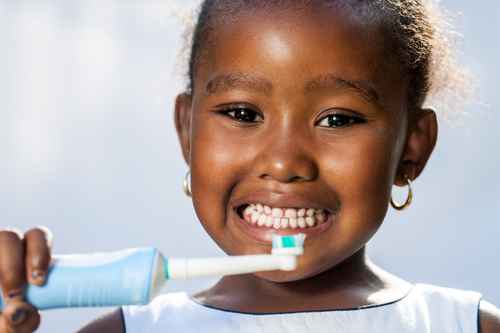 It is important to maintain the health of the primary or baby teeth to establish a good foundation of oral health for your child. Neglected primary teeth frequently lead to problems that can affect developing permanent (adult) teeth and create a lifetime of dental problems.
It is important to maintain the health of the primary or baby teeth to establish a good foundation of oral health for your child. Neglected primary teeth frequently lead to problems that can affect developing permanent (adult) teeth and create a lifetime of dental problems.
Primary baby teeth are essential for proper chewing and eating: they are the first steps in the digestive system. Primary teeth affect speech development, provide space for the permanent teeth and encourage normal development of the jaw and surrounding muscles. They also contribute to an attractive appearance. Unhealthy teeth can lead to poor self-esteem and other issues that affect one’s confidence, and can prevent a child from reaching his or her full potential.
When will my child begin losing his/her baby teeth?
We do everything possible to keep your child’s primary teeth healthy and to be ready for permanent teeth. Your child may have some of those primary teeth until he or she is a teenager!
The following charts show the approximate timing for tooth eruption and replacement.
What’s the best toothpaste for my child?
 Tooth brushing is one of the most important tasks for good oral health.
Tooth brushing is one of the most important tasks for good oral health.
When selecting toothpaste for your child, make sure to choose one that is recommended by the American Dental Association and include the ADA Seal of Acceptance. These toothpastes have undergone objective scientific evaluation and testing to insure they are safe and effective to use.
For very young children, use an amount of toothpaste smaller than a baby pea or just a smear. It’s important for parents and caregivers to help children get in the habit of spitting out toothpaste after brushing. Toothpaste is NOT a food.
Why are you so concerned about decay?
Dental decay in children is on the rise. According to a February 2010 report from the Centers for Disease Control and Prevention, dental decay is the most common chronic disease of childhood – five times more common than asthma!
The good news is that we know that decay detected at the beginning stages of enamel demineralization can actually be reversed using fluoride as a trace mineral. Demineralization refers to the damage done to the tooth’s enamel caused by acid from the bacteria; when this occurs, important minerals have been depleted from the enamel. Demineralization is also commonly referred to as a ‘white spot’ or ‘white spot lesion.’ However, we can reduce demineralization with careful applications of fluoride in the office. When the tooth enamel begins to harden again, it is called–no surprise!–remineralization. If caught in time, remineralization allows the tooth to avoid the need for a traditional filling. We monitor and track these areas of concern at every dental visit so these teeth can stay healthy and avoid fillings if at all possible.
Back to Top
What’s the scoop on fluoride and teeth?
Fluoride has been studied, tested and proven to be beneficial to teeth and helpful in reducing cavities. Fluoride is a trace mineral found naturally in many water sources; it strengthens the enamel of your teeth at a molecular level. The U.S. Public Health Service credits fluoride with reducing the cavity rate over the last several generations.
Despite this wonderful benefit, our bodies need just the right amount of fluoride – not too much and not too little. Too little fluoride will eliminate any health benefits and leave the enamel of teeth at risk for decay. Ask us if you have any concerns about the appropriate amount of fluoride for your child.
How can I help my child stop sucking his/her thumb?
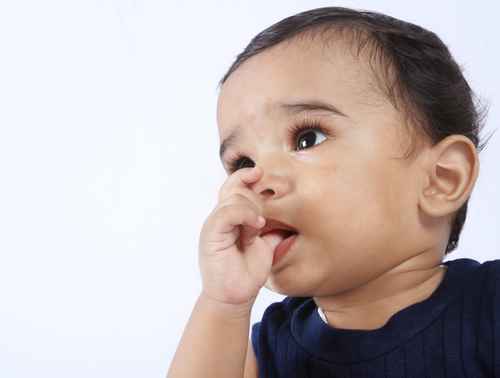 Sucking is a natural reflex and a self-calming habit for very young children. Infants and young children frequently use thumbs, fingers, pacifiers and other objects to suck to create a sense of relaxation and induce sleep. It may make them feel secure and happy or provide a sense of security at difficult periods.
Sucking is a natural reflex and a self-calming habit for very young children. Infants and young children frequently use thumbs, fingers, pacifiers and other objects to suck to create a sense of relaxation and induce sleep. It may make them feel secure and happy or provide a sense of security at difficult periods.
Whether or not dental problems result from thumb sucking depends on how intensely a child sucks on fingers or thumbs. Children who rest their thumbs passively in their mouths are less likely to have difficulty than those who vigorously suck their thumbs. Prolonged thumb sucking habits can lead to delayed language skills, speech impediments, tongue thrusting, difficulty in swallowing, prolonged drooling, and cross bites.
Children should cease thumb sucking by the time their permanent front teeth are ready to erupt. Usually, children stop between the ages of two and four when they can begin to verbalize their frustrations. Peer pressure also causes many school-aged children to stop.
Pacifiers are no substitute for thumb sucking. They can affect the teeth essentially the same way as sucking fingers and thumbs. However, use of the pacifier can be controlled and modified more easily than the thumb or finger habit. Please discuss your concerns about thumb sucking or use of a pacifier with the doctor during your child’s dental exam.
Here are a few ideas to help you help your child reduce occurrences of thumb sucking:
• Don’t scold children for thumb sucking. Instead, praise them when they do not.
• Children often suck their thumbs when feeling insecure or anxious. Focus on correcting the cause of anxiety, instead of the thumb sucking.
• Reward children when they refrain from sucking during difficult periods, such as when being separated from their parents.
• At bedtime, place a bandage on the thumb or cover the entire hand with a sock or mitten.
• Practice “not sucking” while reading a book or watching a video so that the calming behavior of reading or watching isn’t linked to the sucking habit.
• Don’t talk and answer if your child speaks to you with the thumb or fingers in the mouth. Wait to answer them when their thumb or fingers are OUT.
If the habit continues past age four, we may recommend an appointment with a therapist that specializes in muscle behavior modification, or alternatively, using a dental appliance like a night guard that will block your child’s thumb from entering his or her mouth.
Behavior modification, not criticism, is the best way to encourage your child to stop thumb sucking.
Help! My child grinds his/her teeth at night!
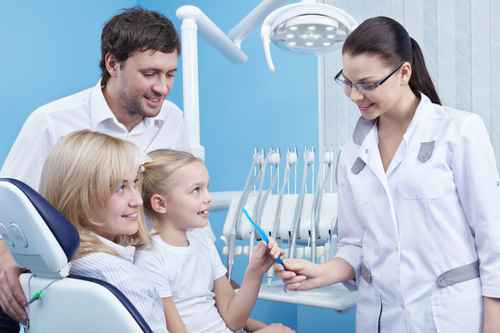 Parents are often concerned about the nocturnal grinding of teeth called bruxism. Often, the first indication of a problem is the noise created by the child grinding their teeth during sleep or the parent noticing excessive wear – and the teeth getting shorter!
Parents are often concerned about the nocturnal grinding of teeth called bruxism. Often, the first indication of a problem is the noise created by the child grinding their teeth during sleep or the parent noticing excessive wear – and the teeth getting shorter!
Bruxism is not uncommon during the ages when teeth are erupting. The majority of cases of pediatric bruxism do not require any treatment and most children outgrow it on their own. The grinding decreases between ages 6 to 9 years and children tend to stop grinding by age 12.
We don’t know exactly why grinding or bruxism occurs, but there are theories. Stress due to a new environment, divorce, changes at school, etc. can influence a child to grind his/her teeth. Another theory relates to pressure in the inner ear at night. If there are pressure changes in the atmosphere, similar to in an airplane during take-off and landing, the child may move his/her jaw to relieve this pressure and inadvertently grind his/her teeth. It may also occur coincidentally with a growth spurt – the child’s jaw grows and the teeth rub together during that time.
If you suspect bruxism may be affecting your child, mention it to the front office when you make the appointment or to the doctor during your child’s dental exam. If your child also snores, bruxism can be a sign of sleep apnea, so we will want to discuss this with you.